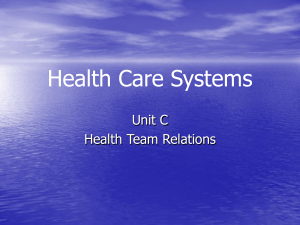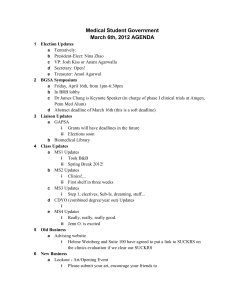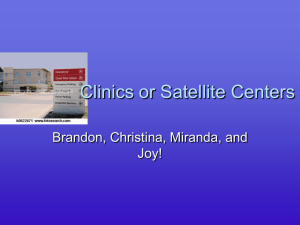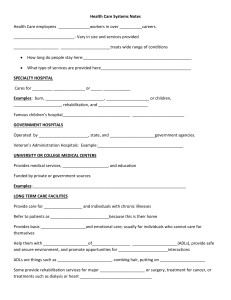Careers Chapter 2
advertisement
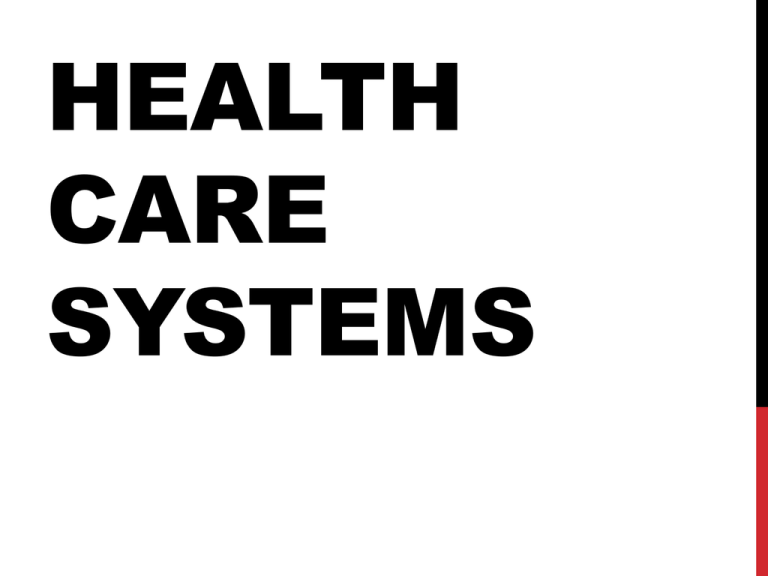
HEALTH CARE SYSTEMS Health care systems include many agencies, facilities, and people involved in the delivery of health care. Private facilities: Require a fee for services. Some use grants and contributions to provide financial services. TYPES OF FACILITIES 1. Hospitals: may be private or proprietary (operated for profit), non-profit or volunteer, religious or government; vary in size and services provided 2. Common types of hospitals 1. 2. 3. 4. General Hospitals: treat a wide range of conditions and age groups (provide diagnostic, medical, surgical and emergency services. Specialty Hospitals: provide care for only special conditions or age groups; examples: burn, cancer, pediatric, psychiatric, orthopedic or rehabilitation. Government Hospitals: operated by federal, state or local government agencies; examples: VA (veterans administration) University or college medical centers: provide hospital services along with research hospital services as well as research and education Long-Term Care Facilities (LTC/LTCF): provide assistance and care for elderly patients (referred to as “residents”) Types of LTCs: Nursing Homes: provide basic physical and emotional care to individuals who can no longer care for themselves with activities of daily living (ADLs) Extended care facilities or skilled care facilities: designed to provide skilled nursing care and rehabilitative care to prepare patients or residents for return to their homes. Independent living and assisted living facilities:provide services such as meals, housekeeping, laundry transportation, social events, and basic medical care (assistance with medications) Medical Offices: May be privately owned by one doctor to large corporations with several doctors. Services include diagnosis, treatment, examination, basic laboratory tests and minor surgeries. Types of medical offices: Pediatrics (infants and children) Cardiology (diseases and disorders of the heart) Obstetrics (care of pregnant female) Dental Offices: Range from single dentist to clinics that hire a group of dentists. Provide dental care to all ages or specialized care to certain age groups or dental conditions. Clinics or Satellite Centers: May be composed of a group of doctors or dentists who share the facility, others may by private and provide specialized care. Types of Clinics: Surgical Centers: perform minor surgeries (day surgeries) Urgent or emergency care: first aid or emergency care Rehabilitation clinics: offer physical, occupational, speech and other therapies Types of Clinics Continued: Specialty clinics: Diabetic or oncology Outpatient clinics: provide care to outpatients Health department clinics: pediatric health care, treatment of sexually transmitted diseases, immunizations, etc. Medical center clinics: offer free or reduced charge treatment from medical students. Optical Centers: can be individually owned or a part of a chain. Provide eye exams, prescribe glasses, etc. Emergency Care Services: Provide care for accident victims or sudden illness. Laboratories: may be part of the other facilities but can operate as separate health care services. Perform diagnostic tests, blood, urine, etc. Some labs perform dental services (dentures) Home Health Care: agencies that provide care in the patient’s home. Types of Home Care: Nursing, personal, therapy, homemaking. Hospice: provide care for terminally ill Mental Health Facilities: provide guidance and counseling, psychiatric clinics and hospitals, chemical abuse treatments, physical abuse treatment Genetic Counseling Centers: Work with individuals or couples considering pregnancy. Provide prenatal screening, checking for abnormalities and birth defects, explaining test results, medical options, coping. Rehabilitation Facilities: help patients with physical or mental disabilities obtain maximum self-care and function Health Maintenance Organizations (HMO): provide for preventive care. HMOs are operated by large industries or corporations. Industrial Health Care Centers: provide health care for employees. School Health Services: found in schools and colleges. Provide emergency care, test for speech, vision, hearing problems & counseling. GOVERNMENT AGENCIES Tax supported agencies. Examples: 1. World Health Organizations (WHO)- sponsored by the United Nations. Maintains information and statistics regarding diseases world-wide. 2. U.S. Department of Health and Human Services (USDHHS)-deals with health problems in the United States 3. National Institutes of Health-part of the USDHHS involved in research on disease. 4. Centers for Disease Control and Prevention (CDC)-part of the USDHHS, concerned with spread and control of disease. 5. Food and Drug Administration (FDA)- regulates food and drugs sold to public. 6. Agency for Health Care Policy and Research (AHCPR)responsible for identify and implementing standards for health care 7. Occupational Safety and Health Administration (OSHA)enforces standards that protect workers from job related injuries. 8. Health departments- provide health services directed by the USDHHS. Voluntary and Nonprofit Agencies: 1. American Cancer Society 2. American Heart Association 3. American Diabetes Association 4. Many others HEALTH INSURANCE PLANS Terms to Know: 1. Deductible: amount the patient must pay for health care before the plan will pay. 2. Co-insurance: percentage shared by patient and insurance plan. 3. Co-payment: amount the patient pays for a service regardless of the total cost of the visit. 4. Health Maintenance Organization (HMO): a monthly fee or premium is paid for membership and the fee stays the same regardless of the amount of health care used. 5. Preferred Provider Organization (PPO): health plan provided by large companies to their employees. Restrict treatment to specific health care facilities. 6. Medicare: provides health care for almost all individuals over the age of 65. 7. Medicaid: usually provided for individuals with low income. 8. Workers’ Compensation: provides for treatment of workers injured on the job. 9. TRICARE: provides for care of military personnel. 10. Managed Care: Cost containment process that requires all health care provided must serve a purpose. ORGANIZATIONAL STRUCTURE All health care systems must have an organizational structure that includes a chain of command.

